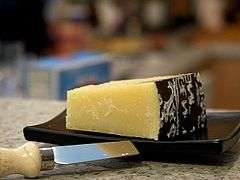Pecorino Romano
Pecorino Romano (Italian pronunciation: [pekoˈriːno roˈmaːno]) is a hard, salty Italian cheese, often used for grating, made with sheep's milk. The name "pecorino" simply means "ovine" or "of sheep" in Italian; the name of the cheese, although protected, is a simple description rather than a brand: "[formaggio] pecorino romano" is simply "sheep's [cheese] of Rome".
| Pecorino Romano | |
|---|---|
| Country of origin | Italy |
| Region, town | Lazio, Sardinia, and Tuscany (Province of Grosseto) |
| Source of milk | Sheep |
| Pasteurised | Yes |
| Texture | hard and very crumbly |
| Aging time | 5 months or more |
| Certification | Certification PDO 1996 |
Even though this variety of cheese originated in Lazio, as the name also indicates, most of its actual production has moved to the island of Sardinia.[1] "Pecorino romano" is an Italian product with name recognized and protected by the laws of the European Community.
Pecorino Romano was a staple in the diet for the legionaries of ancient Rome. Today, it is still made according to the original recipe and is one of Italy's oldest cheeses. On the first of May, Roman families traditionally eat pecorino with fresh fava beans during a daily excursion in the Roman Campagna. It is mostly used in Central and Southern Italy.
Overview

A cheese variety of what might be considered the earliest form of today's Pecorino Romano was first created in the countryside around Rome, its method of production being described by Latin authors such as Varro and Pliny the Elder about 2,000 years ago.[2] Its long-term storage capacity led to it be used for marching Roman legions' rations. A daily ration of 27 grams was established to be given to the legionaries, as a supplement to the bread and farro soup. This cheese gave back strength and vigour to tired soldiers, giving them a high-energy food that was easy to digest.[3] It was produced in Latium until 1884 when, due to the city council prohibiting salting the cheese in their shops in Rome, many Roman producers moved to Sardinia:[4] the island, which had been experiencing a severe reduction of its forest cover as a direct result of human activity, provided the Roman entrepreneurs with a kind of soil that was ideal for the promotion of monoculture farming.[5][6]
It is produced exclusively from the milk of sheep raised on the plains of Lazio and in Sardinia. Nowadays, most of the cheese is produced on the island, especially in Macomer. Pecorino Romano must be made with lamb rennet from animals raised in the same production area,[7] and is consequently not suitable for vegetarians.
Pecorino Romano is most often used on pasta dishes, like the better-known Parmigiano Reggiano. Its distinctive aromatic and pleasantly sharp, very salty flavour led to it being preferred for some Italian pasta dishes with highly flavoured sauces, especially those of Roman origin, such as bucatini all'amatriciana, spaghetti alla carbonara, and spaghetti cacio e pepe (of which it is a main ingredient). The sharpness depends on the period of maturation, which varies from five months for a table cheese to eight months or longer for a grating cheese. Most pecorino cheeses are classified as grana and are granular, hard and sharply flavored.[8]
There are other regional types of pecorino cheese. Pecorino Toscano (from Tuscany) and Pecorino Sardo (from Sardinia) are not particularly salty, and are generally eaten as they are, rather than grated and used as a cooking ingredient. In the United States "Romano cheese" is sold; it is not based on real pecorino Romano, but is a milder cheese made with cow's milk.
See also
- Sardinian sheep
- List of ancient dishes and foods
- List of Italian PDO cheeses
- List of sheep milk cheeses
References
- Damiana Verucci (18 October 2016). "Lazio contro Sardegna, scoppia la guerra del pecorino romano" [Lazio against Sardinia, the Roman pecorino war breaks out]. Il Tempo (in Italian).
- "Pecorino Romano DOP". agraria.org (in Italian). Istruzione Agraria online. Retrieved 12 November 2015.
- "Italian Pecorino Romano History".
- "IL FORMAGGIO DI SARDEGNA - Fiore Sardo Pecorino Sardo Pecorino Romano Canestrati Ricotta Formaggi Molli Formaggi di capra". Archived from the original on 2007-02-20. Retrieved 2007-02-13.
- Alberto Maria Delogu. "Consumiamo il latte di pecora: è quello più sano". La Nuova Sardegna.
- Irene Melis. "Sardegna arida? Era ricca di boschi, l'hanno devastata". Globalist.it.
- "Il Disciplinare di Produzione" (PDF). pecorinoromano.com. 31 December 2012. Retrieved 1 January 2013.
- "Pecorino Romano". The Gourmet Cheese of the Month Club. Retrieved 2019-10-22.